A Look at Tempus Projects’ Residency Program
by Caitlin Albritton
Combining the best of immersive time in the studio with the added perk of travel, artist-in-residence programs have become the norm for artists to pursue just as much as exhibitions. Allowing for the opportunity to disrupt routine and refresh oneself in an unknown location, work made during residencies can change the course of artists’ careers.
In order to nourish the art community, Tempus Projects – an artist-run non-profit gallery housed in Seminole Heights now reaching their 10th anniversary this year– stepped to the plate to bring a residency experience to the Tampa Bay Area. While there are other local residency programs, like Morean Art’s Center for Clay’s AIR or USF’s invitation-only Kennedy Family Artist and Scholar in Residency, there is a gap in open-application residencies for national and international interdisciplinary artists.
“It was something that I had wanted to do with Tempus from the beginning. When we had the opportunity for the apartment above the Project Space, we took it,” says Tracy Midulla, Founder, Programing Director and Board Chair of Tempus Project.

Tempus Project’s residency started in 2016 with an invitation extended to Kalup Linzy, who is a previous graduate from the University of South Florida’s BFA and MFA programs. Commingling with local artists to use as actors in his performances, Linzy used his studio time to create scenes for his soap opera videos that he has become known for.
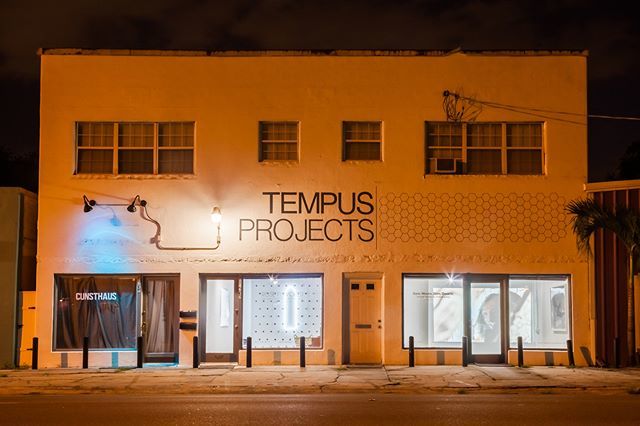
In a live-work environment, artists implement both the upstairs apartment and the back half of CUNSTHAUS (an additional exhibition and project space next to Tempus Projects that’s main goal is to create an engaging space for a variety of cultural programs and experiences with a low-key emphasis on showing women artists) as their studio space, where they have access to a modest collection of tools to suit their needs along with a $1,000 stipend. To celebrate the end of a residency, the artist presents their most recent works in an exhibition that is usually accompanied by an artist talk at the opening reception and a private cocktail party for the Sustaining Members, whose contributions help fund these residencies along with general operational funding (and previously from ACHC grants).
Decisions, decisions: the difficult selection process
As Tempus Projects begins to get its name out, they have seen residency applications from all over the globe. The open call for their Sunistra exhibition–with over 280 submissions—helped get them on artists’ radars. With their most recent residency open call, Tempus received 63 applications, many of them coming from Georgia, New York, and Florida.
While they don’t give a preference to a certain type of artist, they prefer non-Tampa-based artists since they feel that they can best support local artists in other ways. Trying to do as many residencies as possible in a year, typically two artists are selected from the open call, while other residents are selected by referrals.
“The reason we do our selections as a committee is because we all look at it differently. We are a well-balanced committee, so some may look more closely at their resume and writing, while others might look more closely at the imagery. Everybody has something that they look for, but we don’t give preference to any particular artist. We tend to look at work that is more engaging and relevant to social topics. We look for the most challenging work,” Midulla explains. “Overall, it’s been pretty easy for us to select artists. What it comes down to is that we all have two or three of the same favorites, then we look at the best fit.”
While “success” in terms of how a residency concludes is highly subjective, Tempus Projects has found that the most successful projects revolve around a strong work ethic and the ability to balance time well.
“We’ve had some artists where they didn’t make any work while they visited, then we had other artists that highlighted their time here, and this was indicative in the work they made. They were immersed in local culture, but also made the time for their work. They really got to know our city and community of artists. Kalup Linzy has roots in New York but lives here part-time. While Jenal Dolson (2017 AIR alumnus) was here, she ended up being recruited by USF for their master’s program. Roxanne Jackson (2018 AIR alumnus) is always trying to find reasons to come back to Tampa, and I think that’s exciting that even if they don’t stay here, they have a long-term relationship with us. That’s how we’re serving Tampa and our visiting artists through this residency,” Midulla says.
The artist’s residency experience: creating lasting bonds
Though it may have a small grass-roots foundation, Tempus Projects’ influence and notoriety has spread. Whether having heard about the residency online or meeting a Tempus supporter or board member in passing, sights have pointed artists to Tampa with Tempus becoming a noteworthy destination in itself. In Jenal Dolson’s case, an initial interest in the Tampa Drawers Sketch Gang [a drawing collective previously run out of Quaid Gallery, which was previously housed in Tempus’s Project Space] turned into an exhibition opportunity, which led to her learning about the residency.
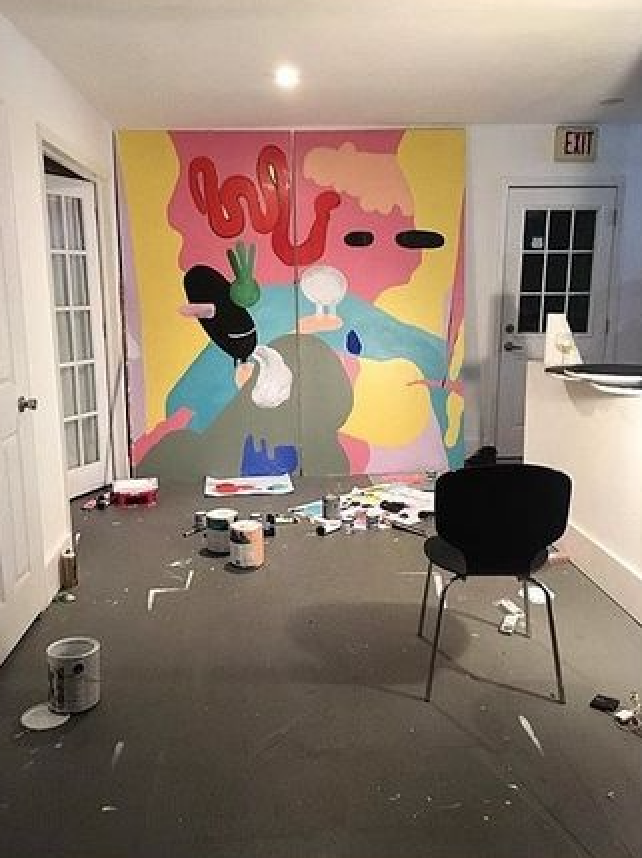
“My residency proposal talked about my interest in the visuals of choropleths and geology. I was thinking I’d try to focus on something thematic as I’ve always been fascinated with the solid spaces of land, which seemed to be at odds with the marshy swiss-cheesiness of Florida. I was—and still am—interested in the duality of meanings that can be grown out of these notions,” Dolson says. “I love a change of scenery when starting a new body of work. I started projecting images onto panels and editing stills of them on my computer, which helped me look at the space around the work in a new way. It helped me take the step towards breaking a few boundaries or rules I was stuck in, and let me explore a more desired inventory of materials.”
In between studio time, Midulla invited Dolson to all of the local arts and culture events as well as set up studio visits with folks within the art community like Tempus Board Members, local artists, curators, and college faculty and recent MFA graduates.
“It made me feel very welcome, and I’m really grateful to have made some lasting relationships. I had always been interested in doing an MFA a few years after I graduated from the University of Waterloo, but I had never lived anywhere other than Ontario. When people in Tampa learned that I was looking at grad schools, they suggested I apply at USF, so I did. I felt like there was a community to insert myself into here. Despite getting into another program I thought I was set on at the University of Guelph, the universe said, ‘Go to Tampa.’”
Community ties
Other than one-on-one studio visits, many artists have taken their residency opportunity to work collaboratively with local artists and institutions.
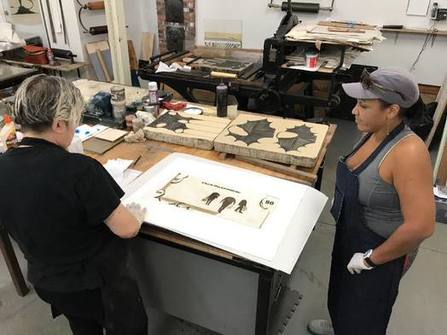
Rodriguez’ 2017 exhibition.
“We research the artist’s work, get to know them for a few days, and try to get them in touch with people in the area to help them facilitate their needs,” Midulla says. “Cuban artist Marian Valdez Rodriquez was part of our International Artist Exchange Program, and she worked on a print edition with Bleu Acier [a Tampa-based limited edition fine art publisher and collaborative workshop run by Master Printer Erika Greenberg-Schneider].”
“The Tempus Projects residency is well-suited to artists who work collaboratively and are interested in community engagement,” says Katherine Pill, Curator of Contemporary Art at the Museum of Fine Art in St. Peterburg and a long-term Tempus Projects Board Member. “It’s always important to remember that we don’t exist in a vacuum. Creating bridges between different arts communities is extremely valuable in terms of gaining an outside perspective and being introduced to new ideas and ways of doing things. A 2017 panel discussion we organized at the MFA allowed for a public talk regarding the US-Cuba artist exchange that Tempus initiated with the Escuela Nacional de Bellas Artes “San Alejandro.” Christina Humphreys, a San Francisco-based artist and a graduate of USF who was able to spend a month working in Havana, and Cuban artist Marian Valdéz Rodriguez, who had spent a month in Tampa, were present and were able to speak about their respective exchange experiences.”
Artist team LIZN’BOW were selected for their new youth project A Talk Show with LIZN’BOW, which was set up like a workshop series at Community Stepping Stones, a local Sulpher Springs-based non-profit organization using arts-steeped pedagogy to educate and inspire at-risk youth, using a talk show format for the kids to explore different social and identity potentialities.
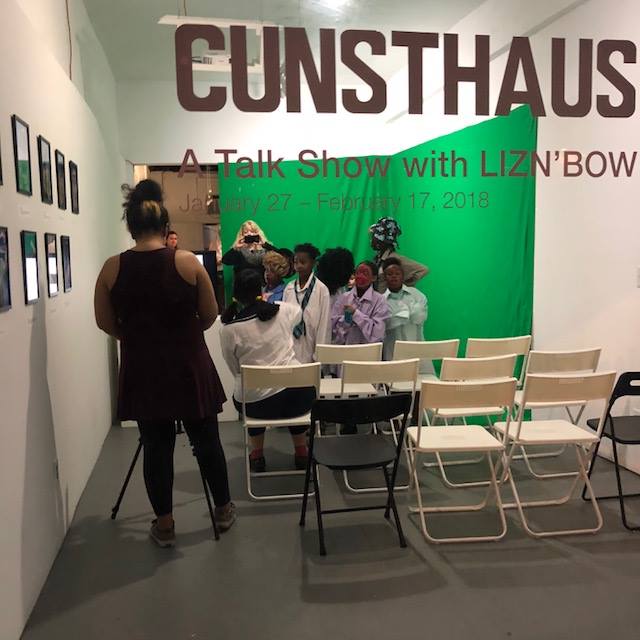
January 27 – February 17, 2018, at CUNSTHAUS
“Our project with Community Stepping Stones needed every minute we had: we were teaching workshops several days a week and editing the footage from class at night while preparing for the talk show. The actual show ended up being a live audience and live stream performance using work different elements from our classes to bring it together,” LIZN’BOW say. “The kids had so much fun and always had something to say. We really like giving kids a lot of agency, which they like a lot and aren’t used to in normal classroom settings. Every time we had a different workshop session, they had big reactions because we pushed them to experiment, like during our makeup sessions. They got pretty wild adding globs of lipstick all over their face. At first, they would judge the experience, but after actually doing it they would get excited, laugh, and want to do it again.”
The community overall was helpful in supporting LIZN’BOW’s project and helping it come to fruition, allowing for additional informal collaborations to nourish the next generation of artists and thinkers. By the end of their residency, LIZN’Bow had two exhibitions: a LIZN’BOW Retrospective in one gallery, and A Talk Show in the other.
“The day of the show was really special and a lot of folks really liked what we did with them, including the kid’s parents. The Stepping Stones kids and Tempus Projects folks became our community during that time,” LIZN’BOW explain. “I think that ideas that are worked out and through between a group of people can be more powerful than an idea coming from just one person. Doing creative and social work can also be very difficult materially and emotionally, and having the support from several different places and people can be crucial in seeing a project and concept grow.”
Even well after these projects have finished, students at Community Stepping Stones who participated in the Talk Show still brag to new students about their live-feed gallery debut.
“The most notable moment in these projects is the pride the kids take in their work. We can really see the difference it makes to them. First, they might be standoffish with new artists or dismissive of the medium—these are some pretty skeptical kids—but as the lesson unfolds and they connect to these new experiences, they become very excited and confident about it. It is really just the best thing to see,” says Michelle Sears, Director of Programs at Community Stepping Stones.
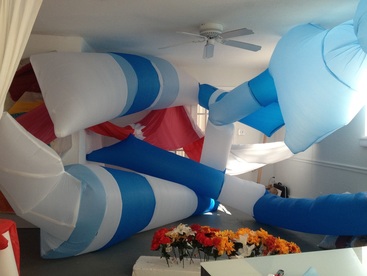
Recent Works by Mike Stasny, September 17 – October 8, 2016
Tempus Projects
Mike Stasny from Atlanta was another Tempus resident artist who came to work with these students for two 2-hour sculpture classes. The young artists were asked to imagine their subject (whether a dog, an old-fashioned radio or a person) stretched out in strange ways to pull the animals and objects out of proportion. Using foam and wire, they created new and unusual artistic “monsters.”
“They were so excited and thoroughly enjoyed themselves. We try to introduce as many different artists and experiences as possible to our classes,” Sears says. “These are extremely meaningful collaborative experiences to the students. It opens their world view and exposes them to new ways of thinking about how they connect to people and their world in general, and they take these experiences home. Our students’ families visit our classroom regularly and they see what the kids are doing and they have conversations about it, and I believe those conversations strengthen bonds and open doors to possibilities and a new understanding of many different things.”
Tempus Projects has hosted eleven artists and two artist groups since their first residency, but what’s so special about Tampa as a destination to drive artists to come? Whether being enchanted by the tropics, wishing to work collaboratively with the community, or a myriad of other reasons, it’s clear that there’s a fascination with this place; there’s something luscious and mysterious that causes artists to gravitate to this area that encourages a different kind of growth.
“We have other interesting projects here that bring people here, but I think the weirdness of Tampa is the driving curiosity for these artists,” Midulla says.
—————-
Caitlin Albritton is a freelance writer based in Tampa with a BFA from Savannah College of Art and Design and an MFA from Maryland Institute College of Art. A practicing artist, you can learn more about her practice by following her on Instagram @caitlinalbritton or visiting her website.
